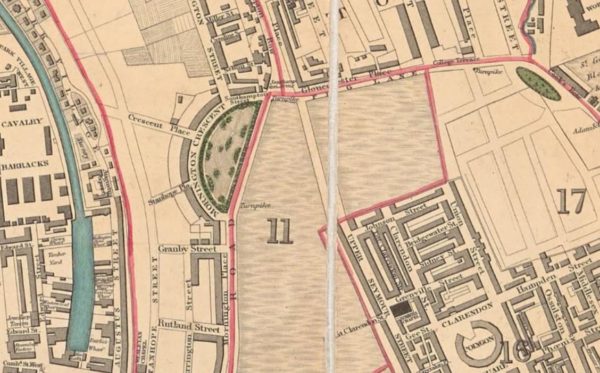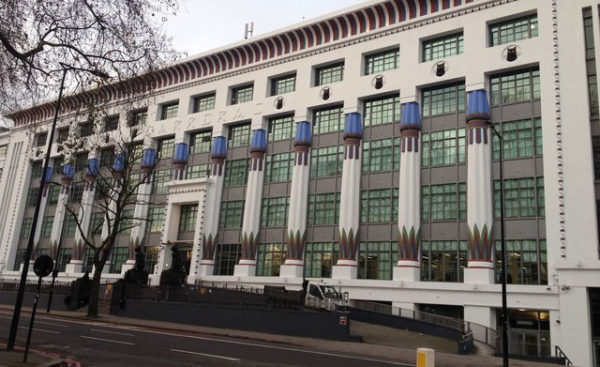This year marks the 200th anniversary of the construction of Mornington Crescent. The name is famous for a radio game and a tube station, but both are named after a row of houses that once dominated the area, but are now hidden away behind another famous landmark.
Mornington Crescent sits on part of what was the Southampton Estate, land associated with Tottenhall Manor that had been given to the Earl of Arlington by Charles II. The Earl’s daughter married Henry Fitzroy, (Earl of Euston) in 1672, and their descendents were later to became Lord Southampton.
It was another Henry Fitzroy, the 5th Duke of Grafton who started leasing lands he owned to developers taking advantage of the growth of London, particularly around the Euston area.
It’s said that the crescent is named after the Earl of Mornington.
Lady Anne Wesley, the only daughter of Garret Wesley, 1st Earl of Mornington and sister of the Duke of Wellington, married Henry Fitzroy, son of the first Baron Southampton. Fitzroy died young, but it’s said that Mornington Crescent is named after the family link.
Construction started in 1820, with the first houses completed a year later, and fully completed in 1832, although today it looks like a street around the back of a large office block it was originally laid out as a grand crescent of Georgian houses around a private park.
Extract from the Topographical survey of the Borough of St Marylebone. Engraved by B. R. Davies from surveys & drawings by F. A. Bartlett under the direction of J. Britton (London, 25 June 1834).
Compared to the other developments of the area at the time, Mornington Crescent was a landmark, with buildings a couple of storeys higher than most, and the crescent marking a shift from the grid layout elsewhere.
With paired houses at the end of each arc and classical details in stucco, ironwork balconies and railings (some now listed), they contrast strongly with the earlier, plainer, brick-faced houses nearby.
You can see a better photo of the Crescent and its park here.
The private park was lost in 1928 in a bitterly fought battle as, of all things, a huge tobacco factory was built on it. Today, the front of the factory is seen as an icon of the area, but for the residents of Mornington Cresent, they now look not over a nice park, but at the blank boring back wall of the factory.
The factory was the Carreras Cigarette Factory and famously designed in the art-deco style, with strong use of Egyptian revival architecture. At the time of awarding the £500,000 contract, it was thought to be the largest reinforced concrete building in London, with 9 acres of floor space inside.
However, it sat on the park, which had been bought by Carreras owner, Bernhard Baron when the Southampton Estate leases expired in 1922, and his desire for a factory spurred the origins of the campaign to save London’s garden squares.
Not that everyone agreed, as the park was by then a bit run down, and the houses once grand homes for the upper middle-classes since chopped up into small flats and sub-let. The factory was thought to be an improvement.
However, while this garden crescent was lost, the campaign continued, and resulted in the London Squares Preservation Act of 1931, which banned the construction of buildings other than those needed for the operation of the park on designated parks.
The factory didn’t do much to help the popularity of the houses, and with the railway behind, and tobacco fumes in front the area continued its downward slide.
The factory though closed in 1961 and was turned into offices, and slowly the area has become much more desirable, with the buildings done up, and even some of them converted from flats back into family homes.
Two hundred years after it was built, the park that few know ever existed will never return, but the Crescent remains.











Thanks. Loverly research, I will have to chuck you a few more quid on DonorBox.
The London Squares Preservation Act 1931 is my favorite piece of legislation ever! I
I had a g/f who lived in a tiny bedsit in the middle of the crescent in the 80s. It was all a bit Withnail and I then and desperate. The Carrera building although of merit design-wise perhaps is not a worthy alternative to the much-needed green space it replaced and “largest reinforced concrete building in London” a bit of a back-handed accolade. There was a load of furniture regularly dumped out the back of the building that must have been surplus but nobody in the bedsits had any room to take it! Thanks for this and all contributions.
Thank you for this interesting article.
Although I’ve always liked the design of the factory I think it’s a pity the park was not retained and immensely glad this will no longer be allowed to happen.
Take care and I really appreciate your blog but until I’m back in employment I’m unable to contribute.
I’ve often wondered about the Carerra building and the Mornington Crescent area. Thanks for the information! I hope you keep up your blog throughout our collective quarantine.
I suspect a new set of rules will be added to the radio game in celebration of the annoversary.
Isn’t the factory now occupied by head office of fashion website ASOS?
Walter Sickert lived in Mornington Crescent before the Cigarette Factory obscured the Underground Station,which is itself built in the English version of the Paris Metro’s Art Nouveau. He could see it. Patricia cornwell has suggested Sickert might have been Jack the Ripper.
Until it disappeared recently, a huge board at the end of one of the blocks, advertised the ‘Hotel Splendide’ which I have been told was a brothel.
Many artists and writers live(d) in the area, such as Frank Auerbach, who has painted ‘Mornington Crescent’. Cecil Woolf,related to Virginia Woolf and Leslie Stephens, lived in a side street. till his death recently.
The “Hotel Splendide” board was part of the dressing for a film shot there I believe.
I always knew tobacco factory as the Black Cat building. I think that I remember a logo on the building somewhere?